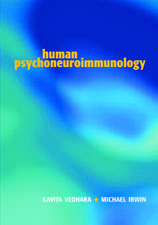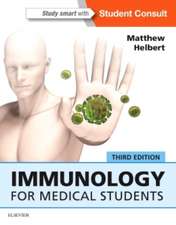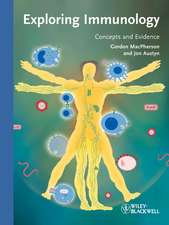Immune Complexes and Human Cancer: Contemporary topics in immunobiology, cartea 15
Editat de Fernando Salinasen Limba Engleză Paperback – 29 apr 2012
Preț: 368.19 lei
Preț vechi: 387.58 lei
-5% Nou
Puncte Express: 552
Preț estimativ în valută:
70.45€ • 73.56$ • 58.18£
70.45€ • 73.56$ • 58.18£
Carte tipărită la comandă
Livrare economică 16-30 aprilie
Preluare comenzi: 021 569.72.76
Specificații
ISBN-13: 9781468449334
ISBN-10: 1468449338
Pagini: 300
Ilustrații: XVI, 280 p. 15 illus.
Dimensiuni: 152 x 229 x 16 mm
Greutate: 0.4 kg
Ediția:Softcover reprint of the original 1st ed. 1985
Editura: Springer Us
Colecția Springer
Seria Contemporary topics in immunobiology
Locul publicării:New York, NY, United States
ISBN-10: 1468449338
Pagini: 300
Ilustrații: XVI, 280 p. 15 illus.
Dimensiuni: 152 x 229 x 16 mm
Greutate: 0.4 kg
Ediția:Softcover reprint of the original 1st ed. 1985
Editura: Springer Us
Colecția Springer
Seria Contemporary topics in immunobiology
Locul publicării:New York, NY, United States
Public țintă
ResearchCuprins
1 Clinical Significance and Nature of Circulating Immune Complexes in Melanoma Patients.- I. Introduction.- II. CIC Detection Methods in Cancer.- III. Incidence of CIC in Melanoma Patients.- IV. Clinical Application of CIC Analysis in Melanoma.- V. Nature of CIC in Melanoma Patients.- VI. Concluding Remarks.- VII. References.- 2 Clinical Relevance of Immune Complexes, Associated Antigen, and Antibody in Cancer.- I. Introduction.- II. Incidence of Immune Complexes in Cancer.- III. Etiology of Immune Complexes.- IV. Pathogenetic Effects of CIC.- V. Role of CIC as Tumor Markers.- VI. Therapeutic Role of Immune Complexes.- VII. Overview and Concluding Remarks.- VIII. References.- 3 The Pathophysiology of Circulating Immune Complexes: Their Role in Host-Tumor Interactions and Removal by Immunoadsorption Therapy.- I. Introduction.- II. Antiimmunoglobulins and Their Effect on the Variety of CIC Formed in the Plasma of Cancer Patients.- III. Interactions of CIC and Complement with the Clotting, Kinin, and Fibrinolyic Systems.- IV. Interaction of CIC with Platelets and Red Blood Cells.- V. The Role of CIC in Lymphocyte Function.- VI. Clinical Significance of CIC in Cancer Patients.- VII. Clinical Treatment Modalities for the Removal of CIC.- VIII. References.- 4 Immune Complexes in Patients Bearing Solid Tumors.- I. Introduction.- II. Detection of CIC.- III. CIC in the Sera of Cancer Patients.- IV. Overview and Conclusion.- V. References.- 5 Immunosuppressor Control as a Modality of Cancer Treatment: Effect of Plasma Adsorption with Staphylococcus aureus Protein A.- I. Introduction.- II. Cellular and Humoral Immunosuppressive Mechanisms in the Tumor-Host Relationship.- III. Soluble Immune Complexes as Predominating Immunosuppressor Molecules in Tumor-Bearing Hosts.- IV. PossibleMechanism of Generation of Immunosuppressive Factors in the Tumor-Bearing Host.- V. Immunotherapy by Controlling the Suppressor Cell Function.- VI. Nature of Specific Plasma Blocking Factors in the Tumor Host.- VII. Control of Serum Blocking Factors as an Approach to Cancer Immunotherapy.- VIII. Plasma Adsorption in Rats Bearing a Chemically Induced Mammary Adenocarcinoma.- IX. Plasma Adsorption in Dogs Bearing a Transplantable Canine Venereal Tumor and Various Spontaneously Occurring Tumors.- X. Plasma Adsorption in Human Cancer Patients.- XI. Possible Mechanisms of Tumor Regression in Plasma-Adsorbed Hosts—An Imbalance in the Dynamic Equilibrium of Immune Complexes Activating the Host Immunity to Fight Cancer.- XII. Infusion of Purified Protein A Showing Effect Similar to Plasma Adsorption.- XIII. Enterotoxin Contamination of Protein A and Its Possible Effects.- XIV. Possible Mechanism of Generation of Various Bioreactive Products following Plasma Adsorption over S. aureus or S. aureus Wood 46 and during Direct Infusion of Protein A.- XV. Summary.- XVI. References.- 6 Blocking (Suppressor) Factors, Immune Complexes, and Extracorporeal Immunoadsorption in Tumor Immunity.- I. Introduction.- II. Specific Blocking Factors.- III. Immune Complexes in Cancer.- IV. Relationship between SBF and Suppressor Cells.- V. Analysis of Suppressor Factors Produced Using Hybridoma Technology.- VI. Immune Modulation by Plasma Treatment: Rationale and Major Findings.- VII. Lymphosarcoma and Persistent FeLV Infection of Pet Cats: A Model to Study Immunological Responses during Extracorporeal Immunoadsorption Treatments.- VIII. Extracorporeal Immunoadsorption Treatments of AIDS-like Syndromes.- IX. Conclusions.- X. References.- 7 Trials of Staphylococcal Protein A-Treated PlasmaInfusions in Cancer Therapy: Clinical Effects and Implications for Mode of Action.- I. Introduction and Background.- II. Methodology.- III. Results.- IV. Discussion of Results and Implications for Mode of Action.- V. Summary.- VI. References.- 8 Protein A Immunoadsorption/Immunoactivation: A Critical Review.- I. Introduction.- II. In Vivo Studies in Laboratory Animals.- III. Clinical Studies.- IV. In Vitro Investigations.- V. Discussion and Conclusions.- VI. References.





















